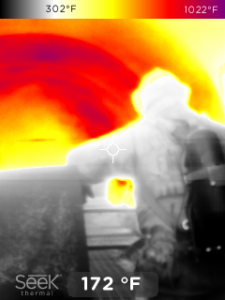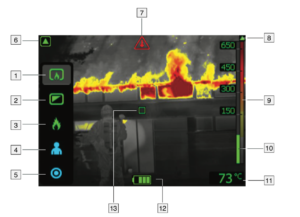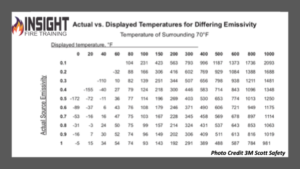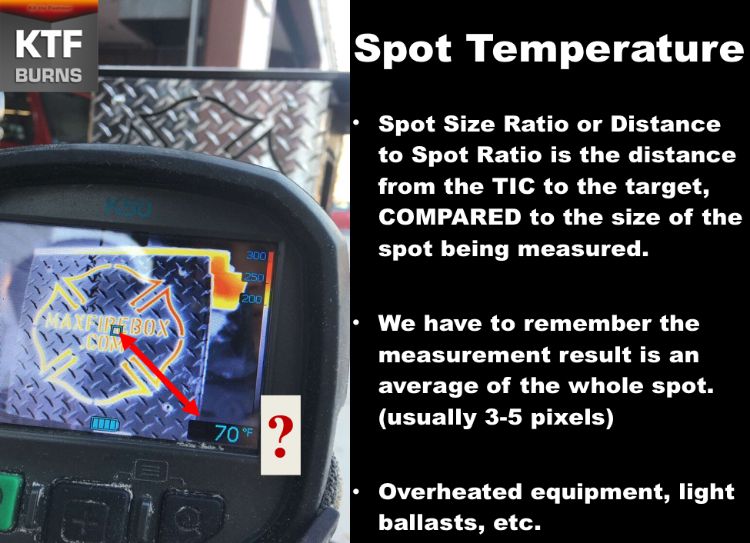One of the most common problems in thermal imaging use in the fire service is the reading of the spot temperature. As we travel and offer training to firefighters, we continue to find that most firefighters are NOT aware that they should NOT use the spot temperature (the numerical temperature indicator located in the lower right corner of the viewfinder) for critical decision making. This spot temperature is known by many names in the Thermal Imaging world such as:
- DTM: Direct Temperature Measurement
• Spot Temperature
• Temperature Indicator
• Crosshair: “Indicated by an intersection vertical and horizontal line superimposed on the TIC Display” (Bullard Definition)
It is important to note that this is an approximate measurement of a defined area and NOT the entire image. And this temperature is dependent upon many variables: the emissivity of the object, distance from the object, and atmospheric conditions. Notice the spot temperature in the image to the above. It is obviously hotter than 172 degrees Fahrenheit, but the TIC is measuring the temperature of the wall of the burn building. It is not accounting for the emissivity of the wall, the distance to the target, and any atmospheric interference between the TIC and the target.

In thermography, there is two types of thermal imaging studies:
- Quantitative: this is typically in an industrial, medical, and or business setting where the thermographer is looking for exact temperature measurements of a specific object or area. This measurement is carefully taken and calculated based on the object’s emissivity, reflectivity, and transmissivity. These values are manually entered into the TIC’s parameters to provide a more accurate temperature measurement.
- Qualitative: this is typically involving inspections or looking for an anomaly or a specific problem but not a specific measurement. This is more applicable to the fire service because it involves reading the entire color palette or image versus reading the spot temperature.

As is displayed in the image, the amount of heat moving over the firefighter’s head is displayed as convection currents, yet the spot temperature shows a relatively low temperature. But this temperature is a small measurement of the overall area within the field of view of the surface and not the gases.
However, the trained end user would note the entire image that is very concerning due to the following:
- Low Sensitivity Mode: This is indicated by the green triangle that is visible and located in the upper left-hand corner of the display. In this brand/model of TIC, this indicates that at least 3% of the overall pixel temperature measurements within the field of view are over 240 degrees Fahrenheit.
- Overall severity of image: Qualitative thermography isn’t about having an accurate interpretation of the temperature but an indication that there is something wrong in the image that needs to be fixed. This photo is a perfect example of that due to the overall amount of heat visible in gray scale, the descending thermal layer, and the fast-moving convection currents that are exhausting from this door frame.
Many firefighters have dismissed such an image as insignificant and non-threatening only to be injured, burned, and suffer a near miss from such a misinterpretation.
Firefighters are under stress to make split second decisions in zero or limited visibility. A TIC that makes this interpretation more complicated or difficult can create more opportunities for misinterpretation rather than using the information to their advantage.
Thankfully, the new NFPA 1801 2021 standard has removed the spot temperature from the TI Basic format. A firefighter who turns on a TIC that meets this standard will be greeted by all the same familiar symbols but will notice the spot temperature is missing.

As shown in the image above, the symbols shown are standard in this model. However, the NFPA 1801 standardized symbols are as follows:
- Low Sensitivity Indicator:
- Overheating indicator: The indicator provides a visual warning to the user that the thermal imager is about to shut down due to internal overheating.
- Change in the color reference indicator symbol. When a new mode is selected, a change in the color temperature reference triangle appears above the reference bar. The triangle remains visible for 1 second.
- Reference Bar
- Temperature Bar
- Spot Meter Temperature (which has been removed from TI Basic).
- Battery Condition Indicator: It consists of four bars with each bar equating to at least 30 minutes of battery life. When the battery bar turns red and is flashing it equates to less than five minutes of battery life remaining.
- Spot meter: This is the area of measurement that the spot temperature is displaying an apparent temperature, but it is based on a preset emissivity of .95-97 at a preset distance and calibrated in a factory. These measurements of “apparent temperatures” can be off by 5-41 degrees from the factory (depending on the model) and those measurements can be up to several hundred degrees off from the actual measurement based on emissivity of the target and other variables.
- Plus sign: This indicates the Thermal Imaging Camera is not in the TI-Basic mode.
As shown in this chart provided by 3M Scott Safety, we can see as the temperature and the difference in emissivity increases so does the variance in displayed temperature from actual temperatures. This is another reason why fire service TICs are not to be used for exact measurements. For example, if a fire is near a polished stainless-steel object such as a refrigerator or stove is reading a temperature on the surface of the metal displayed at 200 degrees Fahrenheit; it is 563 degrees Fahrenheit!

For this reason and more, the spot temperature has been removed from TI Basic on fire service thermal imaging cameras. There have been numerous incidents where firefighters have misread the image based on this measurement. The following examples are why the spot temperature measurement was removed:
- A NIOSH LODD-report cites the following
Engine XX to Command “We have a 184 Degree Fahrenheit reading on the door-thermal imaging reading.” - Numerous reports of Firefighters have misinterpreted the thermal environment based on the spot temperature measurement.
- Rekindles have been reported due to firefighters basing their error of reading the spot temperature
And regarding this issue, NFPA 1801 2021 edition states the following:
“In Chapter 6, the spot temperature measurement feature has moved from the TI BASIC operational format to the TI BASIC PLUS operational format. Despite all thermal imager manufacturer user manual warnings not to use temperature measurement to make tactical decisions, it became apparent in three recent NIOSH Firefighter Fatality Investigation Reports that there is a lack of understanding on behalf of the fire service of the feature’s capabilities. Although the use of the temperature measurement feature was not considered the sole factor in these fatalities, its use and potential misuse certainly could be considered a factor in a cascading series of events that may have been attributed to these fire fighter injuries and fatalities. The move is further substantiated in all previous editions of NFPA 1801 in Subsection 6.5.2, which requires additional training for TI BASIC PLUS operational format functions, enhancements, and innovations beyond TI BASIC.” (Citation NFPA 1801 2021 edition Chapter 6).
While I applaud and support this decision, it is a short-term fix to a long-term problem. The last sentence from NFPA 1801 regarding the removal of the spot temperature summarizes the problem well: “This move is further substantiated in all previous editions of NFPA 1801 in subsection 6.5.2, which requires additional training for TI BASIC PLUS operational format functions, enhancements, and innovations beyond TI BASIC.” The problem remains that few firefighters have had proper thermal imaging training that meets or exceeds NFPA 1801 and NFPA 1408. Firefighters need to understand their specific model of thermal imaging camera, the limitations, and contraindications of thermal imaging, and how to use it to enhance strategies and tactics on the fire ground. If firefighters would have read the instructions, they would find statements such as these: “Do not use the FLIR K Series camera without correct training. If the persons do not have the correct training, an incorrect analysis of the infrared images can occur.” “Do not use temperature indicator readings as exact measurements” Firefighters who read the instructions, would also learn how their TIC calculates “apparent temperatures” and when it switches from High to Low Sensitivity. This is done automatically in fire service TICs. Firefighters do not have the luxury of thermography training nor the time to calculate each measurement. Therefore, the fire service TIC is a qualitative device that provides apparent temperatures automatically based on the temperatures within the measurable field of view. For example, this model of thermal imaging camera changes from High Sensitivity (which equates to 0-302 degrees Fahrenheit) to Low Sensitivity (which equates to 302-1200 degrees Fahrenheit) if more than 2% of the pixels within the measured area constantly (for more than one second) have a temperature above the maximum temperature of the high sensitivity range. Also, an automatic change from low sensitivity to high sensitivity occurs if more than 98% of the pixels within the measured area constantly have, for more than 1 second, a temperature lower than 122 degrees Fahrenheit. (Citation FLIR KXX series instruction manual). Thermography professionals have known this and are aware of the variances in temperature measurement. However, the fire service has placed this valuable life saving device into service without proper training and education. Very few firefighters are aware of the following standards: · NFPA 1801- NFPA 1801 Standard on Thermal Imagers for the Fire Service (introduced in 2013). · NFPA 1408- Standard for Training Fire Service Personnel in the Operation, Care, Use, and Maintenance of Thermal Imagers (introduced in 2015). These standards are extremely valuable and need to be understood by all fire departments using thermal imaging cameras. Through education and training on these standards, firefighters would understand that thermal imaging training and education is “mandatory.” It isn’t optional and due to the failure of our organizations to properly educate firefighters on this device we continue to see injuries and misuse of the device. The following slide provides a few excerpts from NFPA 1408. Notice the word “shall” is used in describing what will be done. This isn’t an option nor a suggestion. If a fire department can purchase thermal imaging camera(s), they are required to provide training on the device. However, the fire service has not elevated thermal imaging training to its proper level of importance. Firefighters should be trained on fire behavior, building construction, PPE, and thermal imaging far more in depth than we currently require or dictate. Firefighters who are fundamentally sound in their knowledge and understanding of these subjects will then use a TIC to their advantage.
In our trainings, travels, and consulting, we continue to see fire departments across the country purchasing thermal imaging cameras without proper research. and then simply placing these devices into service with little or no training on them. How are firefighters to properly use and maximize the effectiveness of such a device without proper training and education? The entire issue of “reading the spot temperature” would have been a moot point if thermal imaging training would have continued to be required with the purchase of these devices as they previously were back in the late 1990’s.
Firefighters who are properly trained will interpret the entire image within the TIC’s field of view. They understand the limitations of the TIC, that the resolution affects its temperature measurement, the distance to the target, and the emissivity all account for their ability to make an adequate assessment.
Taking all of this into consideration helps firefighters to understand they are reading “apparent temperatures” which are approximates not exact measurements. In fact, the temperatures they are seeing are much hotter.
Keep learning and keep up the great work!
Instructor Andy Starnes
Insight Training LLC
Level II Thermography Certified
www.insighttrainingllc.com

